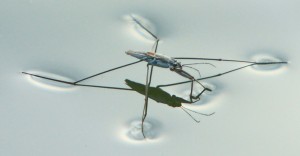Have you ever seen those bugs that just run across the water and you’re like…what the heck, how did they just do that? Well I have no idea, but that’s a question I decided to research and find the answer to. One of the most popular insects to walk on water are called Gerridaes, also  known as water striders. Apparently, scientists have struggled to figure out how these insects really walk on water, however they have an idea to explain this…
known as water striders. Apparently, scientists have struggled to figure out how these insects really walk on water, however they have an idea to explain this…
Before we look at what the insect is doing, we have to see how the water acts. Water is different at its surface than what is below. A term called surface tension plays a role because water molecules are attracted to each other. The water molecules have no other like molecules on all sides allowing them to cohere even stronger, creating tension, which is why when you see the water strider’s leg hit the surface, it doesn’t go into the water.
Now looking at the insect itself, the National Wildlife Federation describes water striders as about a half inch long with a thin body and three sets of legs. The most important feature to look at is their legs. The NWF explains that on their legs are tiny hairs that repel the water they walk on and capture air instead. By doing this, water striders have the ability to move quickly on the surface of water.
Scientists believe that when the tiny hairs on the legs repel the water, it should equal the flotation force. The flotation force goes back to Archimedes principal of buoyancy, commonly  seen in boats and why they can float. It basically says that any object that is partially or all the way in water is buoyed up by a force that’s equal to the weight of fluid displaced by the object. According to the article, How Do Insects Walk on Water? Shadows Reveal Their Secret, author Brooks Hays explains that a group of scientists at Tsinghua University tested their ideas by looking at the shadows created by the water strider’s legs. An experiment was done where they placed a white sheet of paper at the bottom of a water tank and added a light source above. Brooks Hays says that the curvature of the expelled water caused the leg shadows to be rounded. This is important because it allows the scientist to measure the amount of expelled water, which tells them the upward flotation force.
seen in boats and why they can float. It basically says that any object that is partially or all the way in water is buoyed up by a force that’s equal to the weight of fluid displaced by the object. According to the article, How Do Insects Walk on Water? Shadows Reveal Their Secret, author Brooks Hays explains that a group of scientists at Tsinghua University tested their ideas by looking at the shadows created by the water strider’s legs. An experiment was done where they placed a white sheet of paper at the bottom of a water tank and added a light source above. Brooks Hays says that the curvature of the expelled water caused the leg shadows to be rounded. This is important because it allows the scientist to measure the amount of expelled water, which tells them the upward flotation force.
Overall these scientists found out what was happening with their legs and the water and about the different forces involved. This experiment’s results can now lead to an improvement in technology where, from the article Shadow Method Reveals Locomotion Secrets of Water Striders, the possibility to see advanced bionic robots based on these small insect principles can be created in the near future.
To me it’s interesting how simple research of insects could lead to the idea of new technology. Ways like this can be done through many different experiences so who knows what else we may be able to create out of these results.

Great post! I thought this was cool because I have always wondered how they actually stride on water. When it’s explained it seems easy enough. But what I found really interesting was how scientists can actually do from learning this simple yet revolutionary information. They can actually can create new technology just from observing an insect. I found more info on such breakthroughs and found a link on livescience.com explaining the robot that they are designing. Here it is, http://www.livescience.com/51728-insect-inspired-robot-jumps-on-water.html Thanks for the post!